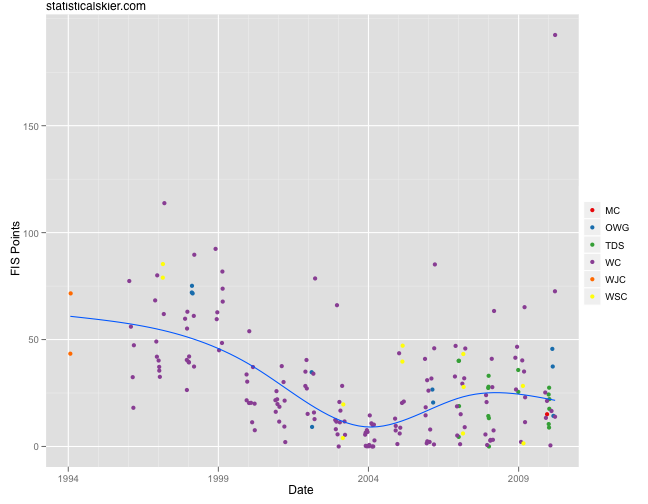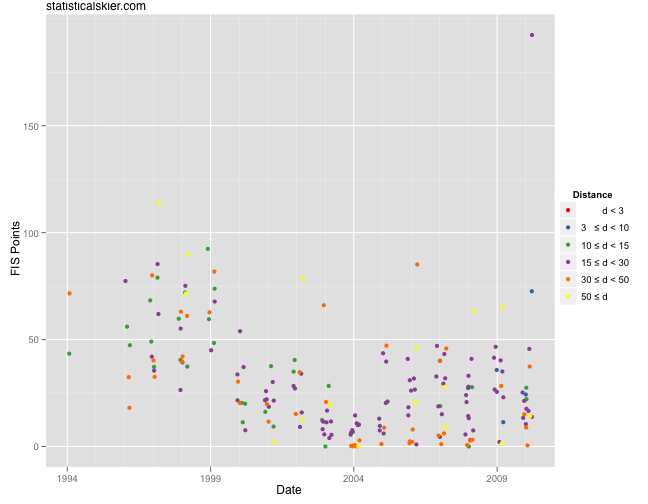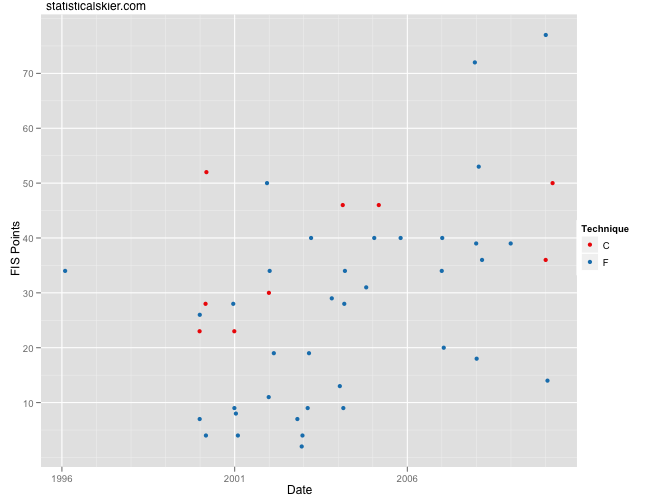Long time German skier Rene Sommerfeldt is retiring this year. Â His international career spans roughly 15 years, which is quite a long time to ski internationally.
I thought it would be fun to honor retiring skiers with a fairly comprehensive look back at their careers. Â But since this is a largely data visualization site, it will all be in graphs. Â But first, some highlights: Sommerfeldt’s only Olympic medals have come in relays (Silver 2006, Bronze 2002). Â He does have one individual podium at World Championships (Silver 2001) in addition to two more relay medals (Silver 2003, Bronze 2001).
Sommerfeldt has had plenty of success in World Cup races, though. Â He’s reached the podium 19 times (4 victories, 9 runner-ups, 6 thirds)[1. I may be counting these differently than other people. Â I count the individual stages of Tour de Ski stage race events as separate events as well as the final classification.]. Â Only one of those podiums was a sprint race. Â His first podium came in February 2000 in a 10km Freestyle in Switzerland, and the last came in March 2008 in a 15km classic race held in Finland.
Among his four victories was a win at the Holmenkollen 50km freestyle in 2004. Â (Which, if you’re not a cross country skiing aficionado, is a big big deal.) Â And of course, this was the season that he won the World Cup overall points classification.
Let’s turn to the data, shall we?
This graph shows Sommerfeldt’s distance results for most of his career, including non-World Cup races.[2. The abbreviations are mostly intuitive, but if you’re not a skiing fan: MC= Marathon Cup, OWG= Olympics, TDS=Tour de Ski, WC= World Cup, WJC= World Juniors and WSC=World Championships.] Â Those first two races in 1994 are from World Juniors. Â The unusually bad race this past season was from the World Cup final in Falun. Â The 15km freestyle handicap start didn’t treat him well that day; he ended up 40th out of 43. Â This was certainly not representative of his career.
You’ll note that Sommerfeldt was fairly fast early on in his career, averaging around 50 FIS points during his first few seasons of World Cup races. Â After this, he rapidly improved, culminating in easily his best season overall, 2004, the year in which he won the Holmenkollen. Â Since that time, he has continued to post top results, but also some slower ones as well.
If we break down these distance results by technique, we get the following graph:
The FC technique refers to pursuit races (half classic, half skating). Â As you can see, Sommerfeldt was probably a somewhat better skater. Â The trend lines, which reflect his “average” race of each technique, reflect this difference fairly consistently throughout his career. Â In addition, you can see that many more of his best races were either freestyle races, or pursuits, which probably are somewhat more weighted towards skating than classic.
If we break down these results by length, there less of a clear pattern:
The category for distances less than 3km doesn’t actually appear; it refers to sprint races. Â The category for races between 3-10km only happens a few times, TDS prologues really.
The only thing I’d note about this is that Sommerfeldt seemed to excel at 30km races (a lot of them pursuits, most likely), particularly post-2004. Â At the very least, he seems to have been better at this distance than at 15km.
Sommerfeldt was primarily a distance racer, which is evident in the following graph depicting his sprint results:
As you can see, there are many fewer races here, particularly later in his career. Â Still, Sommerfeldt did have some decent World Cup sprint results between 2000-2004, including several top-5 finishes and one podium. Â His preference for skating extends into his sprint results as well:
There you have it! Â An entire career in pictures. Â Farewell, Rene!
[ad#AdSenseBanner]





{ 1 } Trackback
[…] Rene Sommerfeldt (GER) […]
Post a Comment